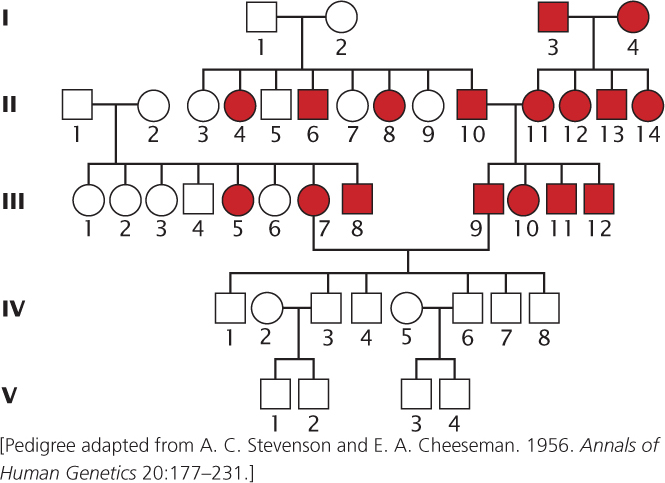Challenge Questions
Section 6.1
Question 6.36
Many genetic studies, particularly those of recessive traits, have focused on small isolated human populations, such as those on islands. Suggest one or more advantages that isolated populations might have for the study of recessive traits.
Section 6.2
Question 6.37
Draw a pedigree that represents an autosomal dominant trait, sex-limited to males, and that excludes the possibility that the trait is Y linked.
Question 6.38
 A. C. Stevenson and E. A. Cheeseman studied deafness in a family in Northern Ireland and recorded the following pedigree (A. C. Stevenson and E. A. Cheeseman. 1956. Annals of Human Genetics 20:177–231).
A. C. Stevenson and E. A. Cheeseman studied deafness in a family in Northern Ireland and recorded the following pedigree (A. C. Stevenson and E. A. Cheeseman. 1956. Annals of Human Genetics 20:177–231).

- a. If you consider only generations I through III, what is the most likely mode of inheritance for this type of deafness?
- b. Provide a possible explanation for the cross between III-7 and III-9 and the results for generations IV through V.
Section 6.3
Question 6.39
Dizygotic twinning often runs in families and its frequency varies among ethnic groups, whereas monozygotic twinning rarely runs in families and its frequency is quite constant among ethnic groups. These observations have been interpreted as evidence for a genetic basis for variation in dizygotic twinning but for little genetic basis for variation in monozygotic twinning. Can you suggest a possible reason for these differences in the genetic tendencies of dizygotic and monozygotic twinning?
Go to your  to find additional learning resources and the Suggested Readings for this chapter.
to find additional learning resources and the Suggested Readings for this chapter.